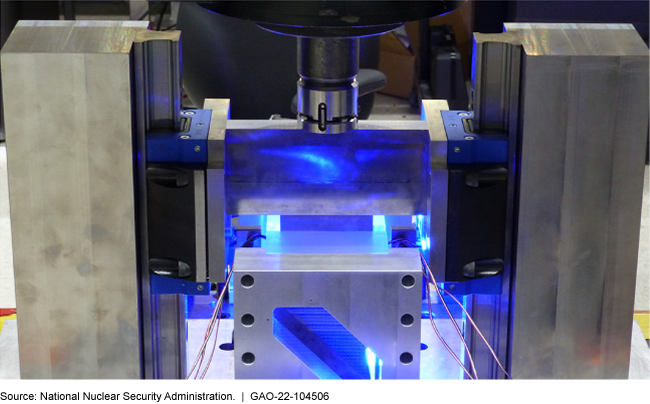Nuclear Security Enterprise: NNSA Could Enhance Its Evaluation of Manufacturing-Related R&D Performance
Fast Facts
In FY 2021, National Nuclear Security Administration laboratory and production sites had about 600 research and development projects underway to modernize manufacturing techniques and find alternatives for obsolete materials and processes.
We found that NNSA's Advanced Manufacturing Development Program fully or substantially followed 5 of 6 leading practices for managing a federal R&D portfolio. For example, NNSA created R&D goals and priorities and coordinated with stakeholders to develop a portfolio. But, NNSA didn't fully develop a process to evaluate the entire portfolio to ensure it meets its goals and priorities. We recommended it do so.
A research and development project tests the strength of additively manufactured metal lattices at the Lawrence Livermore National Laboratory in Livermore, CA.

Highlights
What GAO Found
In fiscal year 2021, National Nuclear Security Administration (NNSA) sites had underway almost 600 research and development (R&D) projects related to manufacturing and spent about $300 million on these efforts. These R&D projects focused on developing innovative manufacturing techniques, such as additive manufacturing, and pursuing alternatives to replace obsolete materials and processes. Four different programs funded these projects. NNSA conducted 133 manufacturing-related R&D projects through its Advanced Manufacturing Development (AMD) program. Contractors that manage and operate NNSA's sites supported 441 additional manufacturing-related R&D projects through the Laboratory-Directed R&D, Plant-Directed R&D, and Site-Directed R&D programs, which are referred to collectively as “directed R&D programs.”
NNSA's management of R&D projects funded under its AMD program generally followed leading practices for managing a federal R&D portfolio (see table below). Specifically, GAO found that NNSA fully or substantially followed five out of six leading practices and partially followed the remaining one. For example, consistent with these leading practices, NNSA developed R&D goals and priorities, coordinated with stakeholders to develop the R&D project portfolio, and tracked these projects using a portfolio-wide system.
Extent to Which NNSA's Advanced Manufacturing Development (AMD) Program Followed Leading Practices for Managing Federal Research and Development (R&D)
|
Leading practice |
Extent followed |
|
Develop and align short- and long-term R&D goals and priorities |
● |
|
Develop an R&D portfolio by prioritizing and selecting projects that align |
● |
|
Identify and coordinate with stakeholders to develop the R&D portfolio |
● |
|
Ensure that the R&D portfolio can adapt to changing goals and priorities |
● |
|
Use a portfolio-wide system to track the progress of R&D |
● |
|
Evaluate the performance of the R&D portfolio |
◒ |
Legend:
● = Fully or substantially followed —NNSA took actions that addressed most or all aspects of the key questions GAO examined for the practice.
◒ = Partially followed —NNSA took actions that addressed some, but not most, aspects of the key questions GAO examined for the practice.
Source: GAO analysis of National Nuclear Security Administration (NNSA) documents and interviews with NNSA officials. | GAO-22-104506
However, NNSA has not fully developed and documented a process for evaluating the performance of AMD's R&D portfolio as a whole. As a result, NNSA may be using inconsistent measures across individual projects to evaluate performance. Moreover, in evaluating the portfolio's performance, officials did not measure progress on long-term R&D goals and priorities. This could limit the agency's ability to determine the extent to which the portfolio provides value in the long term.
Why GAO Did This Study
NNSA is in the midst of a major effort to modernize its nuclear weapons and supporting infrastructure. As part of this effort, NNSA and its sites in the nuclear security enterprise support a variety of R&D projects. These projects explore new manufacturing methods or alternatives to manufacturing processes that may be inefficient, unsafe, or obsolete.
The House report accompanying the Fiscal Year 2021 National Defense Authorization Act included a provision for GAO to review NNSA's manufacturing-related R&D programs. This report (1) describes the manufacturing-related R&D projects underway at NNSA sites and (2) assesses the extent to which NNSA's management of its manufacturing-related R&D projects follow leading practices. GAO analyzed relevant NNSA documents and data, assessed NNSA's management of its manufacturing-related R&D projects against leading practices for managing a federal R&D portfolio, and interviewed knowledgeable officials.
Recommendations
GAO is making two recommendations to NNSA: (1) fully develop and document its process for evaluating R&D portfolio performance for its AMD program and (2) develop measures for assessing progress on long-term R&D goals and priorities for its AMD program. NNSA agreed with the recommendations and described plans to address them.
Recommendations for Executive Action
| Agency Affected | Recommendation | Status |
|---|---|---|
| National Nuclear Security Administration | The Deputy Administrator for the National Nuclear Security Administration's Office of Defense Programs should fully develop and document the process for evaluating the performance of the AMD R&D portfolio. (Recommendation 1) |
As of July 2025, NNSA officials stated that the agency has documented the process for evaluating the performance of the AMD R&D portfolio in a report. We are waiting to receive a copy of the report and will continue to monitor NNSA's actions to address this recommendation.
|
| National Nuclear Security Administration | The Deputy Administrator for the National Nuclear Security Administration's Office of Defense Programs should develop measures for assessing progress on long-term R&D goals and priorities for the AMD program. (Recommendation 2) |
As of July 2025, NNSA officials stated that the agency has developed measures for assessing progress on long-term R&D goals in a report. We are waiting to receive a copy of the report and will continue to monitor NNSA's actions to address this recommendation.
|
